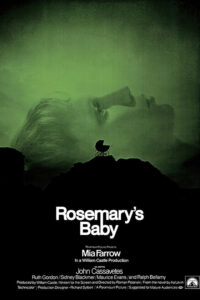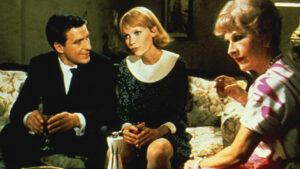“Rosemary’s Baby” – the Devil in New York

Title: “Rosemary’s Baby”
Release Date: 1968
Director: Roman Polański
Cast: Mia Farrow, John Cassavetes, Ruth Gordon, Sidney Blackmer, Maurice Evans, Ralph Bellamy, Victoria Vetri
This movie proved to be a turning point in Roman Polanski’s career. “Rosemary’s Baby” was the first American work by a Polish director and a milestone in the evolution of horror cinema. It was this film that launched the satanic horror genre. Moreover, Polanski’s picture portrays a world of moral crisis and, unlike later works of the genre, offers no prescription for a successful resolution.
“Rosemary’s Baby” – Satan in a New York apartment building
“Rosemary’s Baby” is set in 1960s New York. A young Woodhouse couple moves into a 19th century tenement. One evening, when Guy (John Cassavetes) and Rosemary (Mia Farrow) return home, they find that their young neighbor has committed suicide by jumping out of a window. They soon meet the elderly Castevet couple: Minnie (Ruth Gordon) and Roman (Sidney Blackmer). During their evening together, the neighbor treats Rosemary to a strange dessert, after which the woman suffers a hallucination: she has a vision of being raped by a hairy monster. In the morning, she discovers scratch marks on her body, and her husband admits that a rapprochement took place between them during the night. Rosemary soon discovers that she is pregnant.
The anticipation of the baby tightens ties between the neighbors, Minnie visits the young woman every day and prepares special strengthening cocktails for her. However, the heroine feels very unwell, meanwhile her husband begins to be spectacularly successful as an actor. Soon Rosemary, influenced by a close friend, begins to notice Castevets’ strange behavior. Soon the man falls ill with a mysterious disease and dies, but before that he manages to give Rosemary a book, from which the heroine learns that Roman is in fact the son of Adrian Marcato, a famous sorcerer. From now on, the woman acquires more and more justified suspicions that her husband and neighbors belong to a satanic sect. Despite Rosemary’s efforts, she fails to escape, and after giving birth is informed that her child is dead. One day, however, she hears the cry of an infant coming from behind the wall. She decides to discover the truth, enters a room full of people, stops next to a black crib, and after a while starts rocking the baby.

“Rosemary’s Baby” – two worlds
“Rosemary’s Baby” is a film whose mastery lies in the peculiar duality that governs the depicted world. For here, in modern times, in the midst of metropolitan America, Satan appears. Uncertainty in the viewer arises precisely in the face of this unnatural clash of two radically different realities: the world of sorcery and black magic with a modern, secularized and rational society. Moreover, far more of the extraordinary elements appear here in the everyday lives of the characters than in dreams and hallucinatory visions. Such a treatment by Polanski leaves the viewer in constant suspense, and even that tension builds up, and eventually almost everything becomes fearful.
The duality present in Rosemary’s Baby is perfectly emphasized by the means used in the film. Krzysztof Komeda’s music plays the most prominent role here. The leitmotiv of a nostalgic lullaby is in stark contradiction to the menacing course of events. The melody from the child’s room thus becomes the kind of mesmerizing spell that devil worshippers cast on their victims. The music also underscores the protagonist’s emotional unraveling, her constant balancing on the edge of consciousness. What’s more, Rosemary’s Baby seems to even tangibly affect the senses of the viewer, who can almost feel the tastes and smells, especially in the case of the heroine’s bizarre desserts, cocktails or amulet.
Two interpretations of “Rosemary’s Baby”
The duality of the image of the world in Polanski’s film translates into two interpretive paths. After all, “Rosemary’s Baby” can firstly be read as a story about the crisis of Christianity and traditional morality. It is worth noting that the film was based on Ira Levin’s novel, which had just such overtones. The second half of the 1960s in America was as conducive as possible to a pessimistic picture. In 1966 Anton Sandor LaVey founded the Church of Satan in the US, and extreme relativism began to dominate social attitudes. Moreover, Polanski does not outline any hope for change in his film.

The viewer’s tension is not relieved; not only is evil not defeated, but it actually accumulates and triumphs, dragging the most pure of human instincts – the maternal instinct – into its action. In this sense, “Rosemary’s Baby” clearly differs from later satanic horror films such as “The Exorcist” (1973) and “The Omen” (1976). This is because these films represent a manifestation of faith in the possibility of salvation through Christian values.
Nevertheless, there is also a second interpretation of Polanski’s film. It is worth noting that the director, unlike the novel, in the final scene did not show the face of the child. We only learn that the heroine asks what happened to his eyes. Therefore, there is a certain ambiguity – it is not clear whether what the heroine sees is true, or whether it is only her distorted perception of reality. Analyzing the film as a whole, it can be noted that the narrative is carried out precisely from the point of view of a woman. Every scene takes place in her presence, the camera follows her gaze – sometimes she surreptitiously looks through the door, sometimes she notices strange behavior of her husband or neighbors.
Therefore the suspicion arises that Rosemary may have a disturbed perception of the world. As a result of being raped by her own husband, she gets a shock and begins to become paranoid. She does not accept the pregnancy, and later has symptoms of postpartum depression. Which of these versions is closer to the truth? This is what the film does not settle, and it is in this suspense that the greatness of “Rosemary’s Baby” lies.
Literature:
A.Garbicz, “Kino, wehikuł magiczny. Przewodnik osiągnięć filmu fabularnego. Podróż czwarta. 1967 – 1973”, Kraków 2000.
